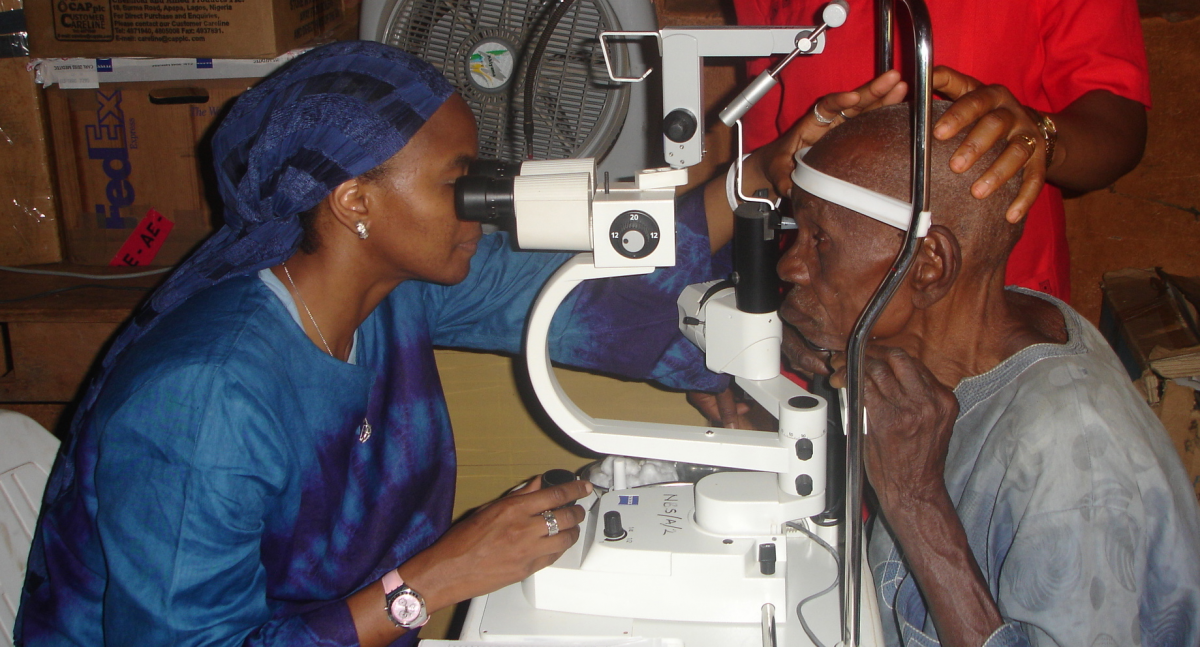Join a powerful, unprecedented alliance for better eye health for all.
Join IAPB-
Choose an alternate language here

Applanation tonometry: accurate measurement of intraocular pressure is important in the diagnosis and treatment of glaucoma/ Photo credits: Gabriel Entekume
Glaucoma affects at least one in every 25 people aged 40 years and above in Sub-Saharan Africa (SSA). It occurs as a result of the intraocular pressure (eye pressure [IOP]) being too high for the normal functioning of the optic nerve which is responsible for sight. Despite the vision loss that it causes, over half of the people with glaucoma are unaware and this is reflected in their late presentation in seeking care. A staggering 50% have already lost vision in one eye and are at high risk of losing vision in the second eye by the time they seek treatment.
There are three main modalities for treatment of glaucoma: medical, surgical or laser therapy. The choice of intervention currently depends on several factors related to the patient: stage/severity at presentation, compliance with health instruction, socio-economic status influencing ability to afford medicines and care, and residence in relation to follow-up. For example, the literate relative of a medical doctor may have medical therapy with 3-monthly follow-up; whereas for a rural non-schooled farmer, the better option may be a one-off surgical treatment (trabeculectomy) with follow-up in the local health centre.
The aim of treatment is to lower the IOP in order to prevent or slow down further vision loss, as any vision already lost cannot be restored. The prognosis when explained is often a source of anxiety to the newly diagnosed patients. Some patients do not accept their diagnosis nor comply with the treatment plan nor accept the prognosis. This leads them to seek multiple opinions in different hospitals, hopping and hoping.
Mrs CP is a 61-year old woman diagnosed with open-angle glaucoma:
“The vision impairment came in my adulthood. In fact, I did not know I had vision impairment, it came quite slowly. Now they say I have to use eye drops for the rest of my life. I cannot even find the drugs to buy and when I find they are so expensive, I cannot afford to buy. Even putting the eye drops is a problem as much of it runs down my face. And it stings.
My vision has worsened. I am tired. I have gone around so many eye clinics without any improvement. In fact, the teaching hospital is worst. I can hardly see and I was asked to go to so many points, pay so many times, wait for so long before I could see the specialist. And to think I have to do this for the rest of my life…Ah!!
I was already blind in one eye and the other eye is also going. Now they said I should have operation in my better eye… God forbid bad thing!! Let me just manage, when I have the money, I will buy the eye drops from the chemist.”
It is therefore imperative that we set our current priorities to:
1. Optimising treatment and patients’ care – i.e. doing the best for those who seek care.
2. Responding to patients’ perspectives with patients’ participation.
Strengthening clinical services would include training in surgical skills, laser procedures and building teams for optimal glaucoma care, for better treatment outcomes. Ensuring that effective medicines are available within well-equipped centres would also expand the treatment choices. Additionally, national guidelines and protocols would be helpful in optimising the diagnosis and treatment of patients.
Population-based surveys in SSA indicate that only about 10% of glaucoma patients seek hospital treatment. Additionally, there is a challenge in keeping patients within the health care system. To engage the patient, there should be counselling to enhance their understanding of the disease and encourage participation of the patient in their choice of therapy and compliance with treatment. The ease of financing mechanisms for their treatment is also important. Additional efforts should be geared towards providing a pleasant hospital experience so that a follow-up visit would entail a one-stop shop.
Eye care providers working together with patients with glaucoma will enhance better treatment outcomes in SSA and together they can be BIG; Beat Invisible Glaucoma.
Liked it? We have a series of posts to mark Glaucoma awareness week. You can see them here: